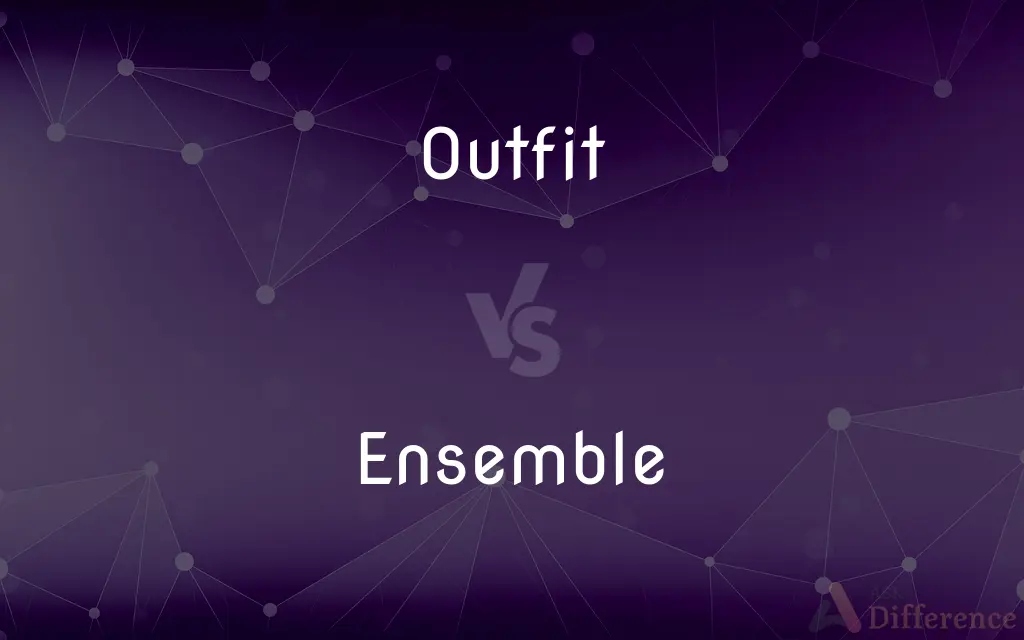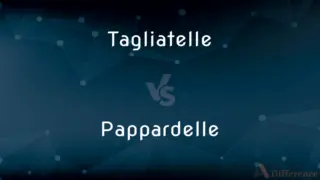Outfit vs. Ensemble — What's the Difference?
Edited by Tayyaba Rehman — By Fiza Rafique — Updated on February 23, 2024
An outfit refers to a set of clothes worn together, often for a specific occasion or purpose, while an ensemble emphasizes a coordinated and harmonious combination of clothing and accessories.

Difference Between Outfit and Ensemble
Table of Contents
ADVERTISEMENT
Key Differences
An outfit typically comprises clothing items put together for daily wear or specific activities, focusing on practicality and personal style. An ensemble, however, conveys a more curated and cohesive look, where each piece complements the others in terms of style, color, and texture, often implying a more thoughtful or artistic approach to dressing.
Outfits can be casual or formal, driven by the wearer's needs or the demands of the occasion. Ensembles, while also adaptable to various settings, lean more towards a unified aesthetic, suggesting a greater attention to detail and the overall effect of the combined pieces.
While choosing an outfit may start with a central piece of clothing, such as a dress or suit, and build from there, creating an ensemble involves considering the interplay of all elements, including accessories, shoes, and even makeup, to achieve a cohesive look.
The term "outfit" is more commonly used in everyday language, relating to a broader range of clothing combinations without necessarily implying a high degree of coordination. "Ensemble," on the other hand, carries a more sophisticated or artistic connotation, often used in fashion or performance contexts to denote a carefully composed appearance.
Despite these differences, the terms can sometimes be used interchangeably in casual conversation, though "ensemble" might suggest a more deliberate or elevated effort in putting the look together.
ADVERTISEMENT
Comparison Chart
Definition
A set of clothes worn together.
A coordinated set of clothes and accessories.
Emphasis
Practicality and personal style.
Harmony and cohesion among all elements.
Context
Daily wear, specific activities.
More curated looks, often implying artistic choice.
Composition
May start with a central piece and add on.
Considers the interplay of clothes, accessories, and more.
Connotation
Casual, everyday use.
Sophisticated, artistic, often fashion-forward.
Compare with Definitions
Outfit
A combination of clothes put together for daily activities.
She chose a comfortable outfit for her day of errands.
Ensemble
A cohesive look comprising clothing and accessories.
Her red carpet ensemble was meticulously coordinated.
Outfit
Can be themed for specific purposes.
His interview outfit included a sharp suit and tie.
Ensemble
Often used in fashion or artistic contexts.
The designer's ensemble featured a blend of modern and traditional elements.
Outfit
Versatile, ranging from casual to formal.
For the wedding, she picked an elegant evening outfit.
Ensemble
Includes consideration of textures, colors, and styles.
Her ensemble was a perfect mix of silk and lace, in complementary shades of blue.
Outfit
Often reflects personal style or function.
Her workout outfit was both stylish and functional.
Ensemble
Implies careful selection and matching.
The ensemble for his concert performance included a custom-tailored jacket.
Outfit
May include basic accessories.
His summer outfit was complete with sunglasses and a hat.
Ensemble
Aims for an overall harmonious effect.
For the gallery opening, her ensemble was an artful balance of elegance and boldness.
Outfit
A set of clothing, often with accessories
What outfit are you wearing to the party?.
Ensemble
A coordinated outfit or costume.
Outfit
A set of clothing (with accessories).
She wore a fashionable outfit with matching purse and shoes.
Ensemble
(fashion) A coordinated costume or outfit; a suit.
Outfit
A complete ensemble of clothing, selected to form a matching set; a coordinated costume; as, a new Easter outfit.
Ensemble
A coordinated outfit (set of clothing)
Common Curiosities
Can an outfit be considered an ensemble?
Yes, an outfit can be considered an ensemble if it involves a harmonious combination of clothing and accessories, carefully put together for a cohesive look.
Is an ensemble more formal than an outfit?
Not necessarily more formal, but an ensemble often implies a higher degree of coordination and thoughtfulness in its composition, which can be applied to both formal and casual looks.
How do you create an ensemble?
Creating an ensemble involves selecting clothing and accessories that complement each other in style, color, and texture, paying attention to the overall aesthetic and harmony of the look.
Are ensembles only for special occasions?
While ensembles are often associated with special occasions due to their curated nature, they can also be crafted for everyday wear, depending on the individual's approach to fashion.
Is choosing an outfit a simpler process than creating an ensemble?
Generally, choosing an outfit can be simpler, focusing more on individual pieces and personal comfort or style, whereas creating an ensemble requires a more detailed consideration of how each component works together.
How do fashion designers use the concept of an ensemble?
Fashion designers often create ensembles to present a cohesive collection, where each piece is designed to complement the others, telling a story or conveying a particular theme or aesthetic.
Can casual wear be an ensemble?
Yes, casual wear can be styled as an ensemble if the pieces are thoughtfully coordinated to achieve a cohesive and harmonious look.
Does an ensemble always include accessories?
While an ensemble often includes accessories to enhance the cohesion of the look, they are not strictly mandatory; the key is the harmonious combination of all elements.
How important is color coordination in an ensemble?
Color coordination is a significant aspect of creating an ensemble, as it contributes to the overall harmony and aesthetic appeal of the look.
Can the same clothing be part of different ensembles?
Yes, the same clothing item can be part of different ensembles, showcasing its versatility when paired with different complementary pieces and accessories.
Share Your Discovery

Previous Comparison
Tagliatelle vs. Pappardelle
Next Comparison
Appellee vs. AppellantAuthor Spotlight
Written by
Fiza RafiqueFiza Rafique is a skilled content writer at AskDifference.com, where she meticulously refines and enhances written pieces. Drawing from her vast editorial expertise, Fiza ensures clarity, accuracy, and precision in every article. Passionate about language, she continually seeks to elevate the quality of content for readers worldwide.
Edited by
Tayyaba RehmanTayyaba Rehman is a distinguished writer, currently serving as a primary contributor to askdifference.com. As a researcher in semantics and etymology, Tayyaba's passion for the complexity of languages and their distinctions has found a perfect home on the platform. Tayyaba delves into the intricacies of language, distinguishing between commonly confused words and phrases, thereby providing clarity for readers worldwide.














































